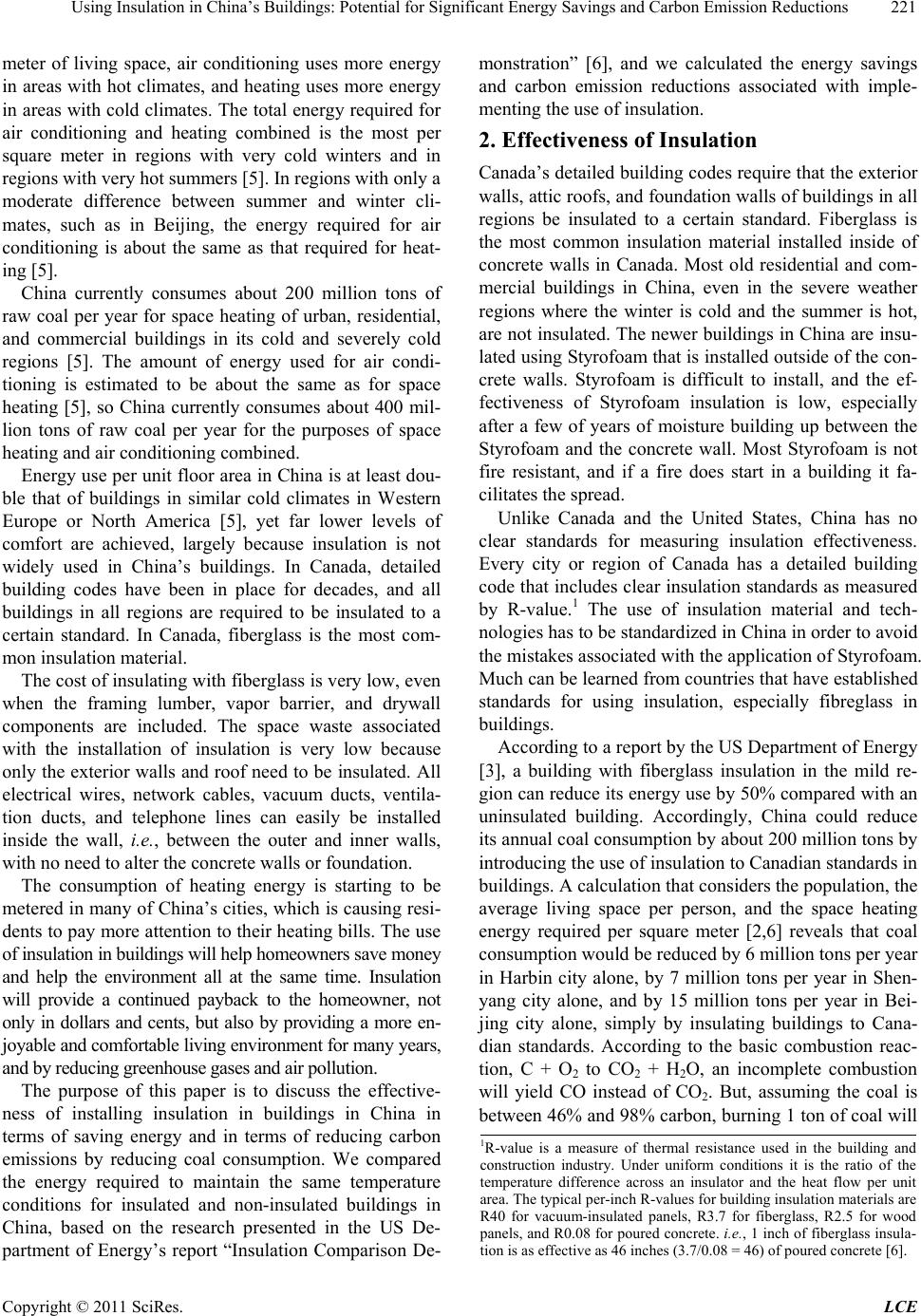
Using Insulation in China’s Buildings: Potential for Significant Energy Savings and Carbon Emission Reductions 221
meter of living space, air conditioning uses more energy
in areas with hot climates, and heating uses more energy
in areas with cold climates. The total energ y required for
air conditioning and heating combined is the most per
square meter in regions with very cold winters and in
regions with very hot summers [5]. In regions with only a
moderate difference between summer and winter cli-
mates, such as in Beijing, the energy required for air
conditioning is about the same as that required for heat-
ing [5].
China currently consumes about 200 million tons of
raw coal per year for space heating of urban, residential,
and commercial buildings in its cold and severely cold
regions [5]. The amount of energy used for air condi-
tioning is estimated to be about the same as for space
heating [5], so China currently consumes about 400 mil-
lion tons of raw coal per year for the purposes of space
heating and air conditioning combined.
Energy use per unit floor area in China is at least dou-
ble that of buildings in similar cold climates in Western
Europe or North America [5], yet far lower levels of
comfort are achieved, largely because insulation is not
widely used in China’s buildings. In Canada, detailed
building codes have been in place for decades, and all
buildings in all regions are required to be insulated to a
certain standard. In Canada, fiberglass is the most com-
mon insulation material.
The cost of insulating with fiberglass is very low, ev en
when the framing lumber, vapor barrier, and drywall
components are included. The space waste associated
with the installation of insulation is very low because
only the exterior walls and roof need to be insulated. All
electrical wires, network cables, vacuum ducts, ventila-
tion ducts, and telephone lines can easily be installed
inside the wall, i.e., between the outer and inner walls,
with no need to alter the concrete walls or foundation.
The consumption of heating energy is starting to be
metered in many of China’s cities, which is causing resi-
dents to pay more attention to th eir heating bills. The use
of insulation in buildings will help homeowners save money
and help the environment all at the same time. Insulation
will provide a continued payback to the homeowner, not
only in dollars and cents, but also by providing a more en-
joyable and comfortable living environment for many years,
and by reducing greenhouse gases and air pollution.
The purpose of this paper is to discuss the effective-
ness of installing insulation in buildings in China in
terms of saving energy and in terms of reducing carbon
emissions by reducing coal consumption. We compared
the energy required to maintain the same temperature
conditions for insulated and non-insulated buildings in
China, based on the research presented in the US De-
partment of Energy’s report “Insulation Comparison De-
monstration” [6], and we calculated the energy savings
and carbon emission reductions associated with imple-
menting the use of insulation .
2. Effectiveness of Insulation
Canada’s detailed building cod es require that the exterior
walls, attic roofs, and foundation walls of buildings in all
regions be insulated to a certain standard. Fiberglass is
the most common insulation material installed inside of
concrete walls in Canada. Most old residential and com-
mercial buildings in China, even in the severe weather
regions where the winter is cold and the summer is hot,
are not insulated. The newer buildings in China are insu-
lated using Styrofoam that is in stalled outside of the con -
crete walls. Styrofoam is difficult to install, and the ef-
fectiveness of Styrofoam insulation is low, especially
after a few of years of moisture building up between the
Styrofoam and the concrete wall. Most Styrofoam is not
fire resistant, and if a fire does start in a building it fa-
cilitates the spread.
Unlike Canada and the United States, China has no
clear standards for measuring insulation effectiveness.
Every city or region of Canada has a detailed building
code that includes clear insulation standards as measured
by R-value.1 The use of insulation material and tech-
nologies has to be standardized in China in order to avoid
the mistakes associated with the application of Styrofoam.
Much can be learned from countries that have established
standards for using insulation, especially fibreglass in
buildings.
According to a report by the US Department of Energy
[3], a building with fiberglass insulation in the mild re-
gion can reduce its energy use by 50% compared with an
uninsulated building. Accordingly, China could reduce
its annual coal consumption by abou t 200 million to ns by
introducing the u se of insulation to Can adian stand ards in
buildings. A calculation th at considers the population, the
average living space per person, and the space heating
energy required per square meter [2,6] reveals that coal
consumption would be reduced by 6 million tons per year
in Harbin city alone, by 7 million tons per year in Shen-
yang city alone, and by 15 million tons per year in Bei-
jing city alone, simply by insulating buildings to Cana-
dian standards. According to the basic combustion reac-
tion, C + O2 to CO2 + H2O, an incomplete combustion
will yield CO instead of CO2. But, assuming the coal is
between 46% and 98% carbon , burning 1 ton of co al will
1R-value is a measure of thermal resistance used in the building and
construction industry. Under uniform conditions it is the ratio of the
temperature difference across an insulator and the heat flow per unit
area. The typical per-inch R-values for building insulation materials are
R40 for vacuum-insulated panels, R3.7 for fiberglass, R2.5 for wood
anels, and R0.08 for poured concrete. i.e., 1 inch of fiberglass insula-
tion is as effective as 46 inches (3.7/0.08 = 46) of poured concrete [6].
Copyright © 2011 SciRes. LCE